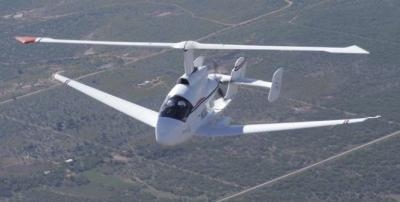Fri, Dec 21, 2012
Four-Place VTOL POC Aircraft Continuing Test Flights
Carter Aviation Technologies ... working in conjunction with Carter Aerospace Development ... says it has made significant progress as performance flight-testing of its current Slowed-Rotor/Compound (SR/C) prototype, the Proof of Concept demonstrator (the “POC”), continues. The POC is a variant of the company’s four passenger vertical takeoff and landing (VTOL) aircraft, known as the 4-Place PAV.

According to the company, the POC is continuing to expand the high speed/slowed rotor envelope. During performance flight-testing in November, the aircraft flew with the rotor slowed to 106 rpm. The company says that by significantly slowing the rotor rpm to less than half that of a comparably-sized helicopter, the aircraft demonstrated a lift-to-drag (“L/D”) value of 12 – around two-and-a-half times better than the most efficient helicopters.
L/D is a measure of the efficiency of an aircraft (lift or weight divided by drag or thrust). Higher L/D ratios are directly related to enhanced speed, fuel economy, climb performance, and glide ratio.
The flight also resulted in an advance ratio of 0.85. The advance ratio is calculated by dividing the forward airspeed of the aircraft by the tip speed of the rotor. As the rotor rpm (i.e., the tip speed) is reduced, the advance ratio increases. As the advance ratio increases, drag on the rotor decreases dramatically, resulting in increased efficiency.
Carter Aviation Technologies says that these key achievements clear the way for the POC to achieve speeds in excess of 200 knots at 25,000 feet and 350 HP with the current test weight of 3,950 lbs. Additionally, the POC has proven its VTOL capability, achieved speeds in excess of 140 knots on 200 HP and an altitude of 12,000 feet.
The company will continue to expand the high speed/slowed rotor envelope at ever-increasing altitudes, and will gather more data on flight efficiencies under those conditions.
(Photo provided by Carter Aviation Technologies)
More News
Aero Linx: Model Aeronautical Association of Australia MAAA clubs are about fun flying, camaraderie and community. For over 75 years, the MAAA has been Australia’s largest fl>[...]
Touchdown Zone Lighting Two rows of transverse light bars located symmetrically about the runway centerline normally at 100 foot intervals. The basic system extends 3,000 feet alon>[...]
“Discovery and innovation are central to our mission at Virgin Galactic. We’re excited to build on our successful record of facilitating scientific experiments in subor>[...]
How To Get A Story On Aero-TV News/Feature Programming How do I submit a story idea or lead to Aero-TV? If you would like to submit a story idea or lead, please contact Jim Campbel>[...]
Student Pilot Reported That During Rotation, “All Of A Sudden The Back Of The Plane Kicked To The Right..." Analysis: The student pilot reported that during rotation, “>[...]
 ANN's Daily Aero-Linx (05.02.24)
ANN's Daily Aero-Linx (05.02.24) ANN's Daily Aero-Term (05.02.24): Touchdown Zone Lighting
ANN's Daily Aero-Term (05.02.24): Touchdown Zone Lighting Aero-News: Quote of the Day (05.02.24)
Aero-News: Quote of the Day (05.02.24) ANN FAQ: Contributing To Aero-TV
ANN FAQ: Contributing To Aero-TV NTSB Final Report: Cirrus Design Corp SR20
NTSB Final Report: Cirrus Design Corp SR20



